MOD001160/MOD001170 - Training & Development Impact at Celcom Malaysia
VerifiedAdded on 2023/06/15
|46
|12242
|245
Report
AI Summary
This report investigates the impact of training and development initiatives on employee performance at Celcom Malaysia, a leading telecommunications provider. It addresses the company's concerns about the effectiveness of past training sessions and the need for improved customer service. The study aims to determine the significance of training and development, analyze their positive impacts, and assess improvements in Celcom's business as a result. It reviews relevant literature, including human capital, competency, and social learning theories, and outlines the research methodology employed, encompassing research philosophy, approach, design, strategy, data collection, and analysis. The research seeks to provide insights into how Celcom can enhance employee performance through targeted training and development programs.
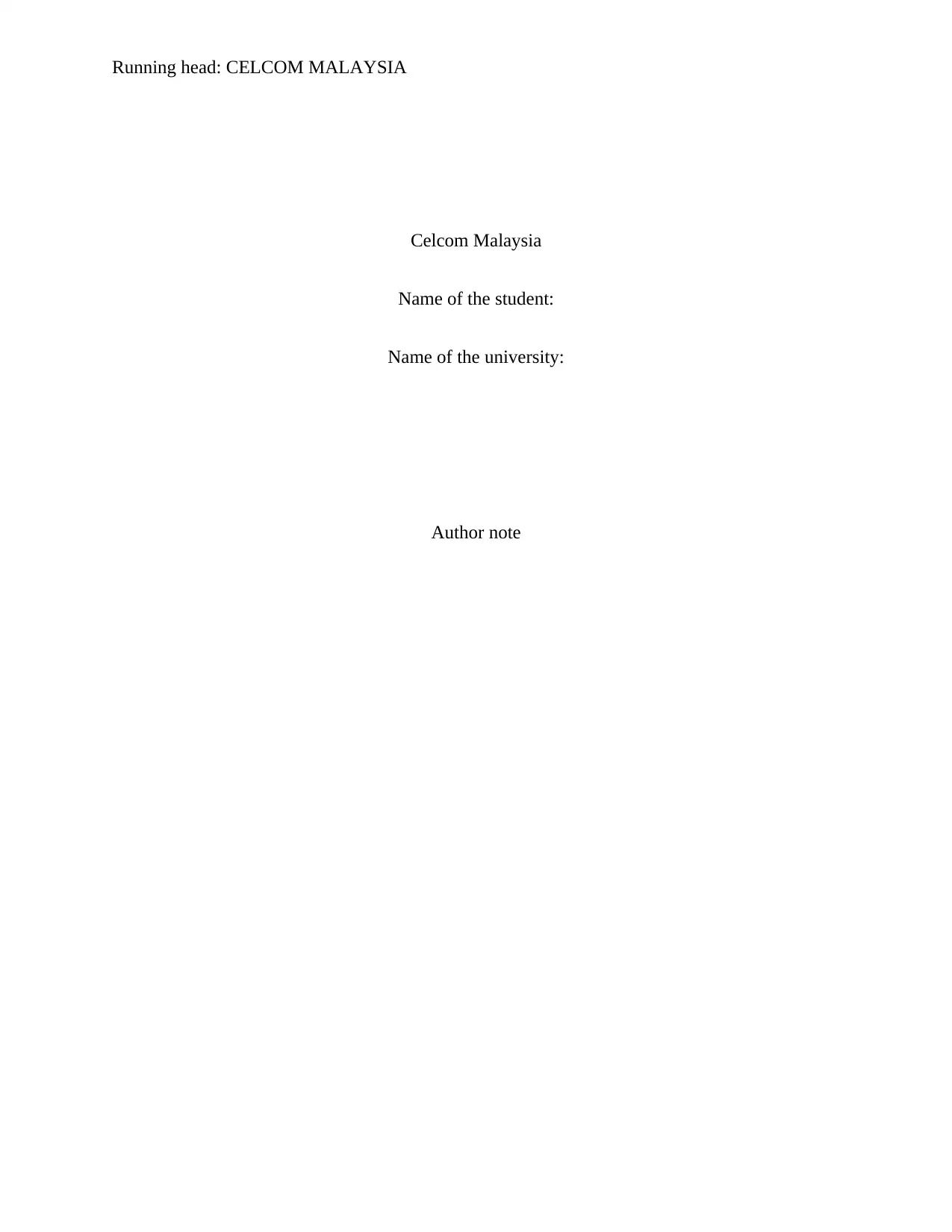
Running head: CELCOM MALAYSIA
Celcom Malaysia
Name of the student:
Name of the university:
Author note
Celcom Malaysia
Name of the student:
Name of the university:
Author note
Paraphrase This Document
Need a fresh take? Get an instant paraphrase of this document with our AI Paraphraser
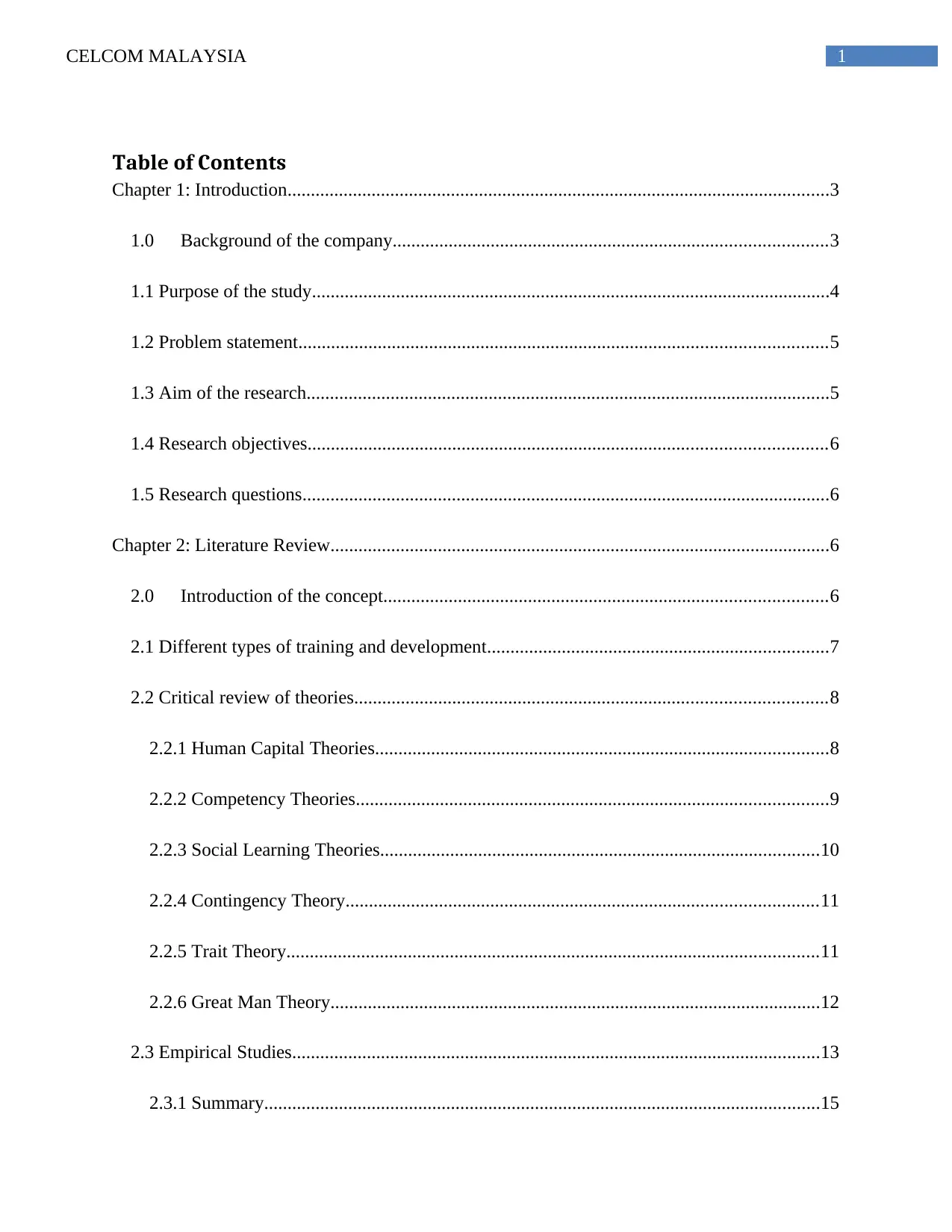
1CELCOM MALAYSIA
Table of Contents
Chapter 1: Introduction....................................................................................................................3
1.0 Background of the company.............................................................................................3
1.1 Purpose of the study...............................................................................................................4
1.2 Problem statement.................................................................................................................5
1.3 Aim of the research................................................................................................................5
1.4 Research objectives...............................................................................................................6
1.5 Research questions.................................................................................................................6
Chapter 2: Literature Review...........................................................................................................6
2.0 Introduction of the concept...............................................................................................6
2.1 Different types of training and development.........................................................................7
2.2 Critical review of theories.....................................................................................................8
2.2.1 Human Capital Theories.................................................................................................8
2.2.2 Competency Theories.....................................................................................................9
2.2.3 Social Learning Theories..............................................................................................10
2.2.4 Contingency Theory.....................................................................................................11
2.2.5 Trait Theory..................................................................................................................11
2.2.6 Great Man Theory.........................................................................................................12
2.3 Empirical Studies.................................................................................................................13
2.3.1 Summary.......................................................................................................................15
Table of Contents
Chapter 1: Introduction....................................................................................................................3
1.0 Background of the company.............................................................................................3
1.1 Purpose of the study...............................................................................................................4
1.2 Problem statement.................................................................................................................5
1.3 Aim of the research................................................................................................................5
1.4 Research objectives...............................................................................................................6
1.5 Research questions.................................................................................................................6
Chapter 2: Literature Review...........................................................................................................6
2.0 Introduction of the concept...............................................................................................6
2.1 Different types of training and development.........................................................................7
2.2 Critical review of theories.....................................................................................................8
2.2.1 Human Capital Theories.................................................................................................8
2.2.2 Competency Theories.....................................................................................................9
2.2.3 Social Learning Theories..............................................................................................10
2.2.4 Contingency Theory.....................................................................................................11
2.2.5 Trait Theory..................................................................................................................11
2.2.6 Great Man Theory.........................................................................................................12
2.3 Empirical Studies.................................................................................................................13
2.3.1 Summary.......................................................................................................................15
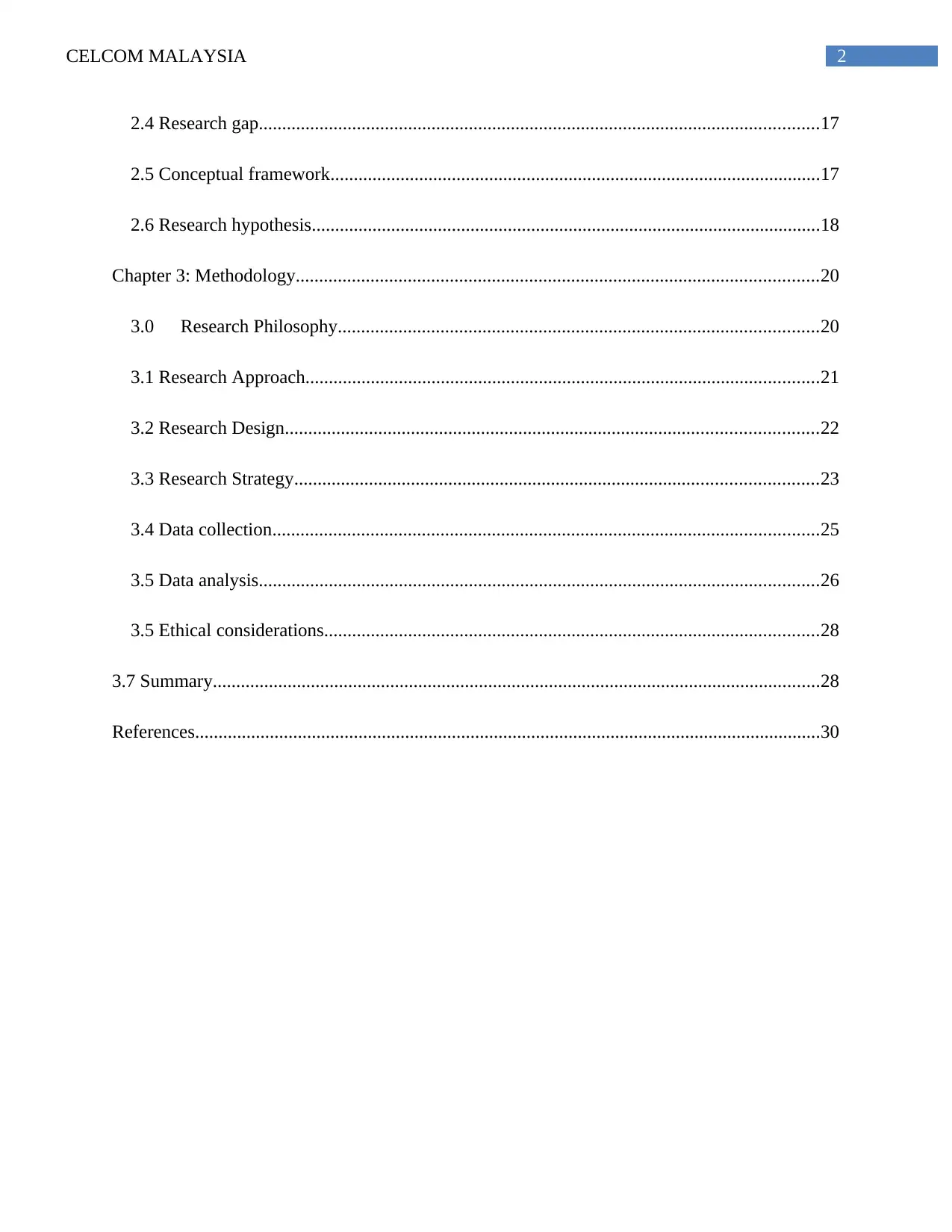
2CELCOM MALAYSIA
2.4 Research gap........................................................................................................................17
2.5 Conceptual framework.........................................................................................................17
2.6 Research hypothesis.............................................................................................................18
Chapter 3: Methodology................................................................................................................20
3.0 Research Philosophy.......................................................................................................20
3.1 Research Approach..............................................................................................................21
3.2 Research Design..................................................................................................................22
3.3 Research Strategy................................................................................................................23
3.4 Data collection.....................................................................................................................25
3.5 Data analysis........................................................................................................................26
3.5 Ethical considerations..........................................................................................................28
3.7 Summary..................................................................................................................................28
References......................................................................................................................................30
2.4 Research gap........................................................................................................................17
2.5 Conceptual framework.........................................................................................................17
2.6 Research hypothesis.............................................................................................................18
Chapter 3: Methodology................................................................................................................20
3.0 Research Philosophy.......................................................................................................20
3.1 Research Approach..............................................................................................................21
3.2 Research Design..................................................................................................................22
3.3 Research Strategy................................................................................................................23
3.4 Data collection.....................................................................................................................25
3.5 Data analysis........................................................................................................................26
3.5 Ethical considerations..........................................................................................................28
3.7 Summary..................................................................................................................................28
References......................................................................................................................................30
⊘ This is a preview!⊘
Do you want full access?
Subscribe today to unlock all pages.

Trusted by 1+ million students worldwide
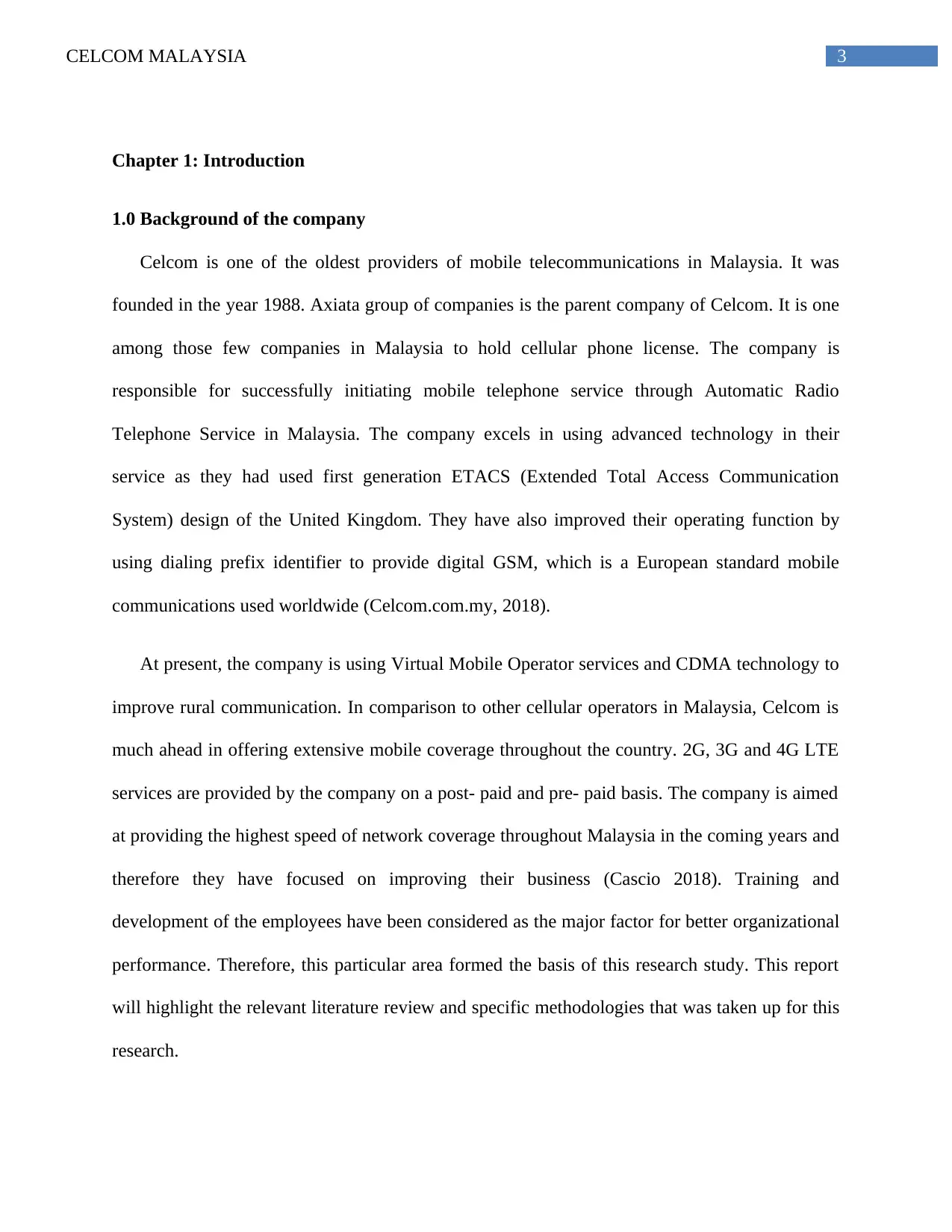
3CELCOM MALAYSIA
Chapter 1: Introduction
1.0 Background of the company
Celcom is one of the oldest providers of mobile telecommunications in Malaysia. It was
founded in the year 1988. Axiata group of companies is the parent company of Celcom. It is one
among those few companies in Malaysia to hold cellular phone license. The company is
responsible for successfully initiating mobile telephone service through Automatic Radio
Telephone Service in Malaysia. The company excels in using advanced technology in their
service as they had used first generation ETACS (Extended Total Access Communication
System) design of the United Kingdom. They have also improved their operating function by
using dialing prefix identifier to provide digital GSM, which is a European standard mobile
communications used worldwide (Celcom.com.my, 2018).
At present, the company is using Virtual Mobile Operator services and CDMA technology to
improve rural communication. In comparison to other cellular operators in Malaysia, Celcom is
much ahead in offering extensive mobile coverage throughout the country. 2G, 3G and 4G LTE
services are provided by the company on a post- paid and pre- paid basis. The company is aimed
at providing the highest speed of network coverage throughout Malaysia in the coming years and
therefore they have focused on improving their business (Cascio 2018). Training and
development of the employees have been considered as the major factor for better organizational
performance. Therefore, this particular area formed the basis of this research study. This report
will highlight the relevant literature review and specific methodologies that was taken up for this
research.
Chapter 1: Introduction
1.0 Background of the company
Celcom is one of the oldest providers of mobile telecommunications in Malaysia. It was
founded in the year 1988. Axiata group of companies is the parent company of Celcom. It is one
among those few companies in Malaysia to hold cellular phone license. The company is
responsible for successfully initiating mobile telephone service through Automatic Radio
Telephone Service in Malaysia. The company excels in using advanced technology in their
service as they had used first generation ETACS (Extended Total Access Communication
System) design of the United Kingdom. They have also improved their operating function by
using dialing prefix identifier to provide digital GSM, which is a European standard mobile
communications used worldwide (Celcom.com.my, 2018).
At present, the company is using Virtual Mobile Operator services and CDMA technology to
improve rural communication. In comparison to other cellular operators in Malaysia, Celcom is
much ahead in offering extensive mobile coverage throughout the country. 2G, 3G and 4G LTE
services are provided by the company on a post- paid and pre- paid basis. The company is aimed
at providing the highest speed of network coverage throughout Malaysia in the coming years and
therefore they have focused on improving their business (Cascio 2018). Training and
development of the employees have been considered as the major factor for better organizational
performance. Therefore, this particular area formed the basis of this research study. This report
will highlight the relevant literature review and specific methodologies that was taken up for this
research.
Paraphrase This Document
Need a fresh take? Get an instant paraphrase of this document with our AI Paraphraser
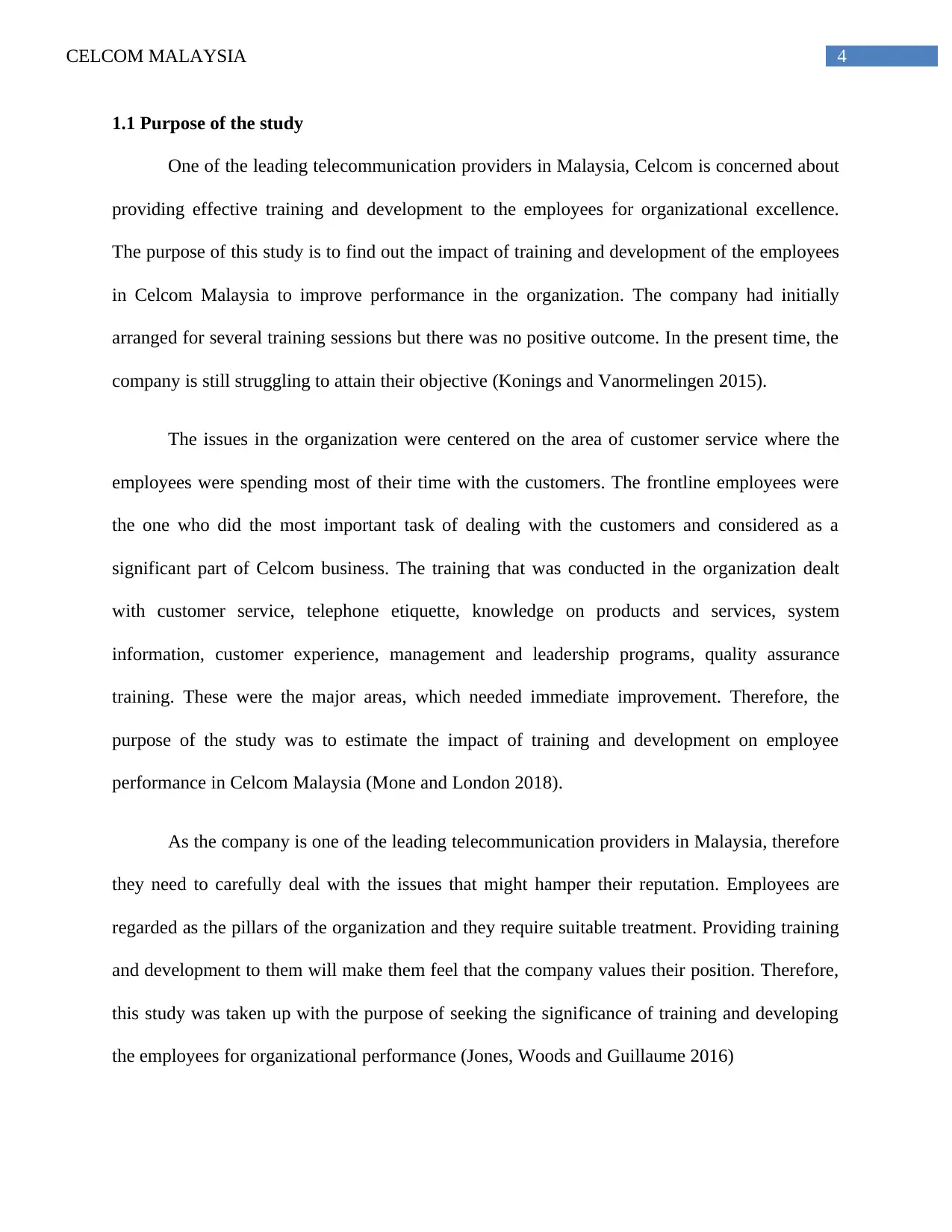
4CELCOM MALAYSIA
1.1 Purpose of the study
One of the leading telecommunication providers in Malaysia, Celcom is concerned about
providing effective training and development to the employees for organizational excellence.
The purpose of this study is to find out the impact of training and development of the employees
in Celcom Malaysia to improve performance in the organization. The company had initially
arranged for several training sessions but there was no positive outcome. In the present time, the
company is still struggling to attain their objective (Konings and Vanormelingen 2015).
The issues in the organization were centered on the area of customer service where the
employees were spending most of their time with the customers. The frontline employees were
the one who did the most important task of dealing with the customers and considered as a
significant part of Celcom business. The training that was conducted in the organization dealt
with customer service, telephone etiquette, knowledge on products and services, system
information, customer experience, management and leadership programs, quality assurance
training. These were the major areas, which needed immediate improvement. Therefore, the
purpose of the study was to estimate the impact of training and development on employee
performance in Celcom Malaysia (Mone and London 2018).
As the company is one of the leading telecommunication providers in Malaysia, therefore
they need to carefully deal with the issues that might hamper their reputation. Employees are
regarded as the pillars of the organization and they require suitable treatment. Providing training
and development to them will make them feel that the company values their position. Therefore,
this study was taken up with the purpose of seeking the significance of training and developing
the employees for organizational performance (Jones, Woods and Guillaume 2016)
1.1 Purpose of the study
One of the leading telecommunication providers in Malaysia, Celcom is concerned about
providing effective training and development to the employees for organizational excellence.
The purpose of this study is to find out the impact of training and development of the employees
in Celcom Malaysia to improve performance in the organization. The company had initially
arranged for several training sessions but there was no positive outcome. In the present time, the
company is still struggling to attain their objective (Konings and Vanormelingen 2015).
The issues in the organization were centered on the area of customer service where the
employees were spending most of their time with the customers. The frontline employees were
the one who did the most important task of dealing with the customers and considered as a
significant part of Celcom business. The training that was conducted in the organization dealt
with customer service, telephone etiquette, knowledge on products and services, system
information, customer experience, management and leadership programs, quality assurance
training. These were the major areas, which needed immediate improvement. Therefore, the
purpose of the study was to estimate the impact of training and development on employee
performance in Celcom Malaysia (Mone and London 2018).
As the company is one of the leading telecommunication providers in Malaysia, therefore
they need to carefully deal with the issues that might hamper their reputation. Employees are
regarded as the pillars of the organization and they require suitable treatment. Providing training
and development to them will make them feel that the company values their position. Therefore,
this study was taken up with the purpose of seeking the significance of training and developing
the employees for organizational performance (Jones, Woods and Guillaume 2016)
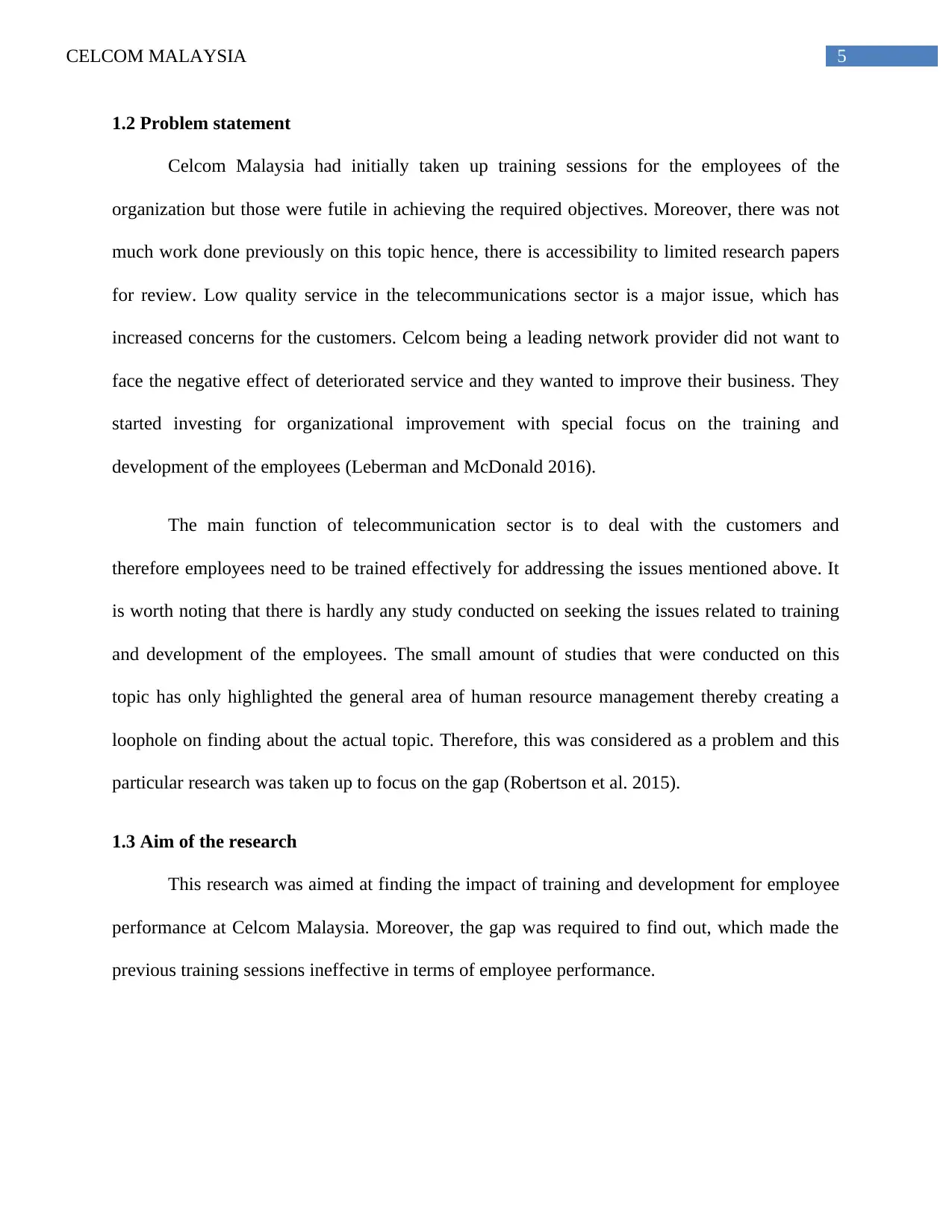
5CELCOM MALAYSIA
1.2 Problem statement
Celcom Malaysia had initially taken up training sessions for the employees of the
organization but those were futile in achieving the required objectives. Moreover, there was not
much work done previously on this topic hence, there is accessibility to limited research papers
for review. Low quality service in the telecommunications sector is a major issue, which has
increased concerns for the customers. Celcom being a leading network provider did not want to
face the negative effect of deteriorated service and they wanted to improve their business. They
started investing for organizational improvement with special focus on the training and
development of the employees (Leberman and McDonald 2016).
The main function of telecommunication sector is to deal with the customers and
therefore employees need to be trained effectively for addressing the issues mentioned above. It
is worth noting that there is hardly any study conducted on seeking the issues related to training
and development of the employees. The small amount of studies that were conducted on this
topic has only highlighted the general area of human resource management thereby creating a
loophole on finding about the actual topic. Therefore, this was considered as a problem and this
particular research was taken up to focus on the gap (Robertson et al. 2015).
1.3 Aim of the research
This research was aimed at finding the impact of training and development for employee
performance at Celcom Malaysia. Moreover, the gap was required to find out, which made the
previous training sessions ineffective in terms of employee performance.
1.2 Problem statement
Celcom Malaysia had initially taken up training sessions for the employees of the
organization but those were futile in achieving the required objectives. Moreover, there was not
much work done previously on this topic hence, there is accessibility to limited research papers
for review. Low quality service in the telecommunications sector is a major issue, which has
increased concerns for the customers. Celcom being a leading network provider did not want to
face the negative effect of deteriorated service and they wanted to improve their business. They
started investing for organizational improvement with special focus on the training and
development of the employees (Leberman and McDonald 2016).
The main function of telecommunication sector is to deal with the customers and
therefore employees need to be trained effectively for addressing the issues mentioned above. It
is worth noting that there is hardly any study conducted on seeking the issues related to training
and development of the employees. The small amount of studies that were conducted on this
topic has only highlighted the general area of human resource management thereby creating a
loophole on finding about the actual topic. Therefore, this was considered as a problem and this
particular research was taken up to focus on the gap (Robertson et al. 2015).
1.3 Aim of the research
This research was aimed at finding the impact of training and development for employee
performance at Celcom Malaysia. Moreover, the gap was required to find out, which made the
previous training sessions ineffective in terms of employee performance.
⊘ This is a preview!⊘
Do you want full access?
Subscribe today to unlock all pages.

Trusted by 1+ million students worldwide
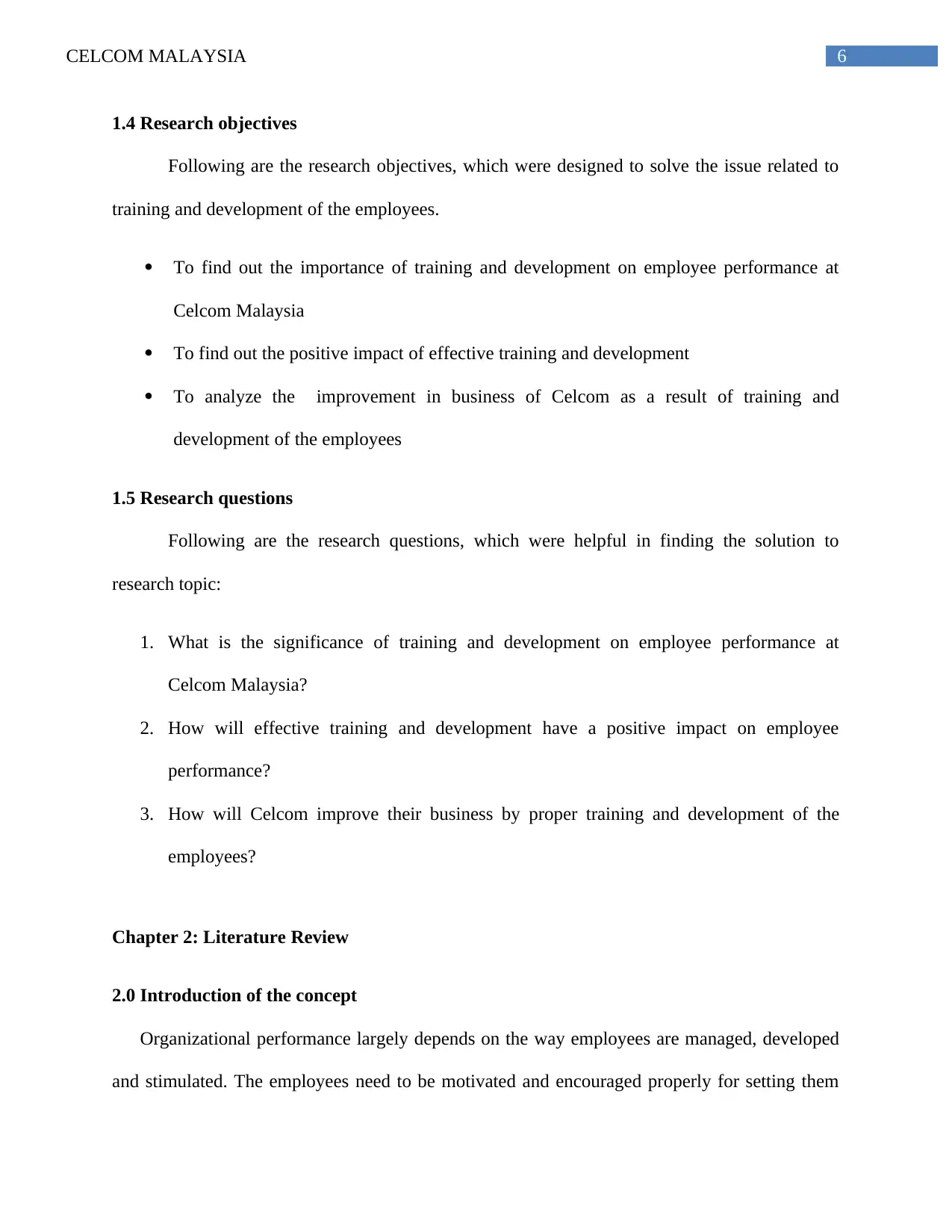
6CELCOM MALAYSIA
1.4 Research objectives
Following are the research objectives, which were designed to solve the issue related to
training and development of the employees.
To find out the importance of training and development on employee performance at
Celcom Malaysia
To find out the positive impact of effective training and development
To analyze the improvement in business of Celcom as a result of training and
development of the employees
1.5 Research questions
Following are the research questions, which were helpful in finding the solution to
research topic:
1. What is the significance of training and development on employee performance at
Celcom Malaysia?
2. How will effective training and development have a positive impact on employee
performance?
3. How will Celcom improve their business by proper training and development of the
employees?
Chapter 2: Literature Review
2.0 Introduction of the concept
Organizational performance largely depends on the way employees are managed, developed
and stimulated. The employees need to be motivated and encouraged properly for setting them
1.4 Research objectives
Following are the research objectives, which were designed to solve the issue related to
training and development of the employees.
To find out the importance of training and development on employee performance at
Celcom Malaysia
To find out the positive impact of effective training and development
To analyze the improvement in business of Celcom as a result of training and
development of the employees
1.5 Research questions
Following are the research questions, which were helpful in finding the solution to
research topic:
1. What is the significance of training and development on employee performance at
Celcom Malaysia?
2. How will effective training and development have a positive impact on employee
performance?
3. How will Celcom improve their business by proper training and development of the
employees?
Chapter 2: Literature Review
2.0 Introduction of the concept
Organizational performance largely depends on the way employees are managed, developed
and stimulated. The employees need to be motivated and encouraged properly for setting them
Paraphrase This Document
Need a fresh take? Get an instant paraphrase of this document with our AI Paraphraser
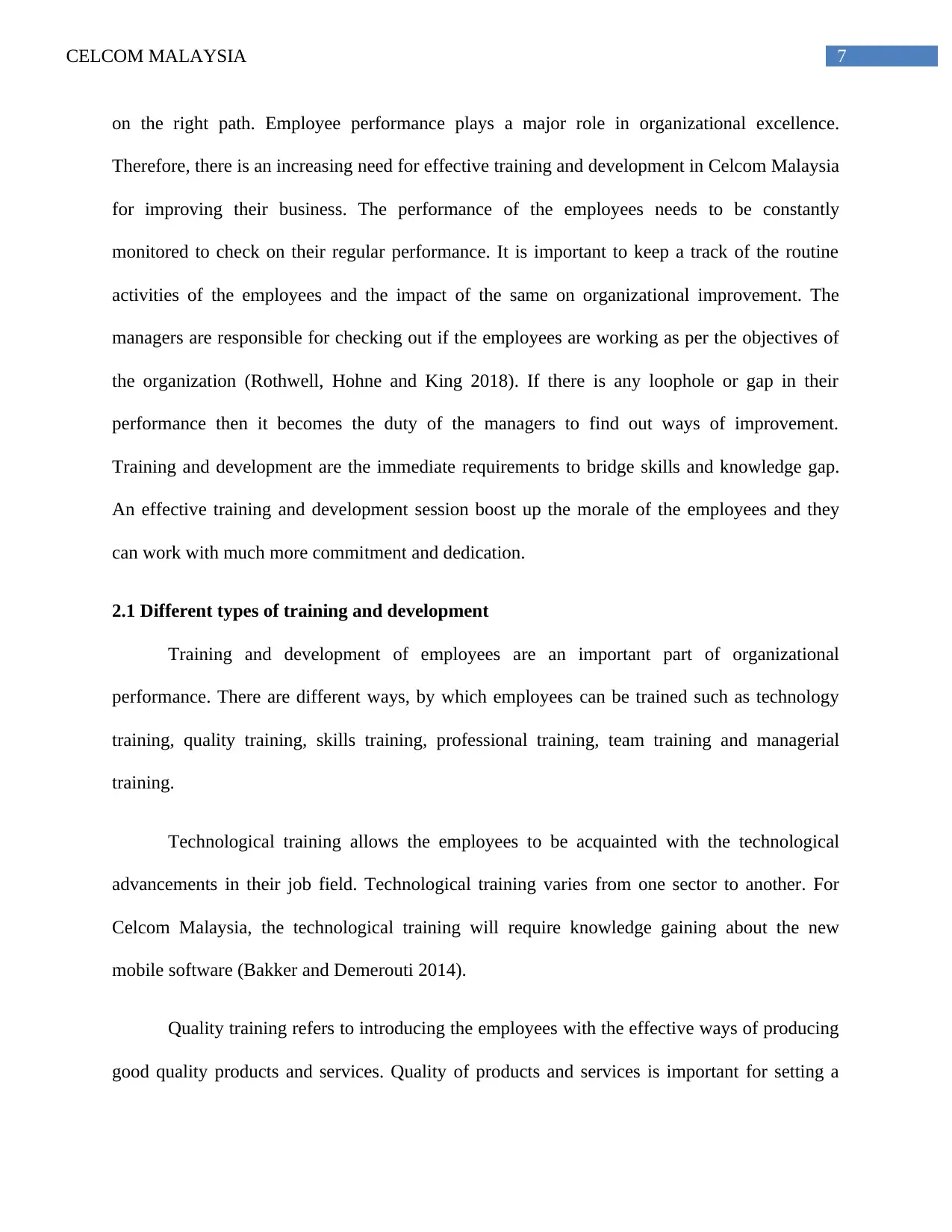
7CELCOM MALAYSIA
on the right path. Employee performance plays a major role in organizational excellence.
Therefore, there is an increasing need for effective training and development in Celcom Malaysia
for improving their business. The performance of the employees needs to be constantly
monitored to check on their regular performance. It is important to keep a track of the routine
activities of the employees and the impact of the same on organizational improvement. The
managers are responsible for checking out if the employees are working as per the objectives of
the organization (Rothwell, Hohne and King 2018). If there is any loophole or gap in their
performance then it becomes the duty of the managers to find out ways of improvement.
Training and development are the immediate requirements to bridge skills and knowledge gap.
An effective training and development session boost up the morale of the employees and they
can work with much more commitment and dedication.
2.1 Different types of training and development
Training and development of employees are an important part of organizational
performance. There are different ways, by which employees can be trained such as technology
training, quality training, skills training, professional training, team training and managerial
training.
Technological training allows the employees to be acquainted with the technological
advancements in their job field. Technological training varies from one sector to another. For
Celcom Malaysia, the technological training will require knowledge gaining about the new
mobile software (Bakker and Demerouti 2014).
Quality training refers to introducing the employees with the effective ways of producing
good quality products and services. Quality of products and services is important for setting a
on the right path. Employee performance plays a major role in organizational excellence.
Therefore, there is an increasing need for effective training and development in Celcom Malaysia
for improving their business. The performance of the employees needs to be constantly
monitored to check on their regular performance. It is important to keep a track of the routine
activities of the employees and the impact of the same on organizational improvement. The
managers are responsible for checking out if the employees are working as per the objectives of
the organization (Rothwell, Hohne and King 2018). If there is any loophole or gap in their
performance then it becomes the duty of the managers to find out ways of improvement.
Training and development are the immediate requirements to bridge skills and knowledge gap.
An effective training and development session boost up the morale of the employees and they
can work with much more commitment and dedication.
2.1 Different types of training and development
Training and development of employees are an important part of organizational
performance. There are different ways, by which employees can be trained such as technology
training, quality training, skills training, professional training, team training and managerial
training.
Technological training allows the employees to be acquainted with the technological
advancements in their job field. Technological training varies from one sector to another. For
Celcom Malaysia, the technological training will require knowledge gaining about the new
mobile software (Bakker and Demerouti 2014).
Quality training refers to introducing the employees with the effective ways of producing
good quality products and services. Quality of products and services is important for setting a
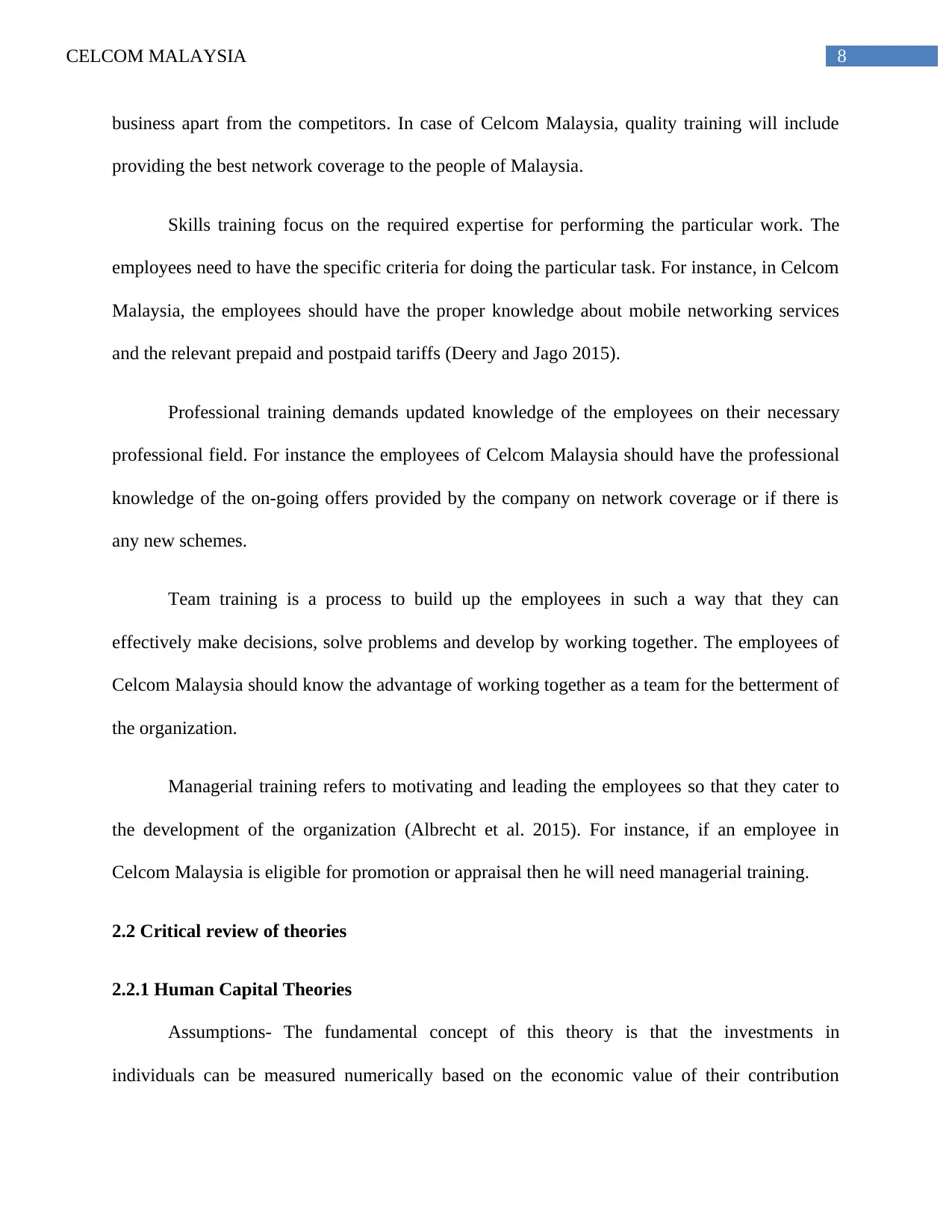
8CELCOM MALAYSIA
business apart from the competitors. In case of Celcom Malaysia, quality training will include
providing the best network coverage to the people of Malaysia.
Skills training focus on the required expertise for performing the particular work. The
employees need to have the specific criteria for doing the particular task. For instance, in Celcom
Malaysia, the employees should have the proper knowledge about mobile networking services
and the relevant prepaid and postpaid tariffs (Deery and Jago 2015).
Professional training demands updated knowledge of the employees on their necessary
professional field. For instance the employees of Celcom Malaysia should have the professional
knowledge of the on-going offers provided by the company on network coverage or if there is
any new schemes.
Team training is a process to build up the employees in such a way that they can
effectively make decisions, solve problems and develop by working together. The employees of
Celcom Malaysia should know the advantage of working together as a team for the betterment of
the organization.
Managerial training refers to motivating and leading the employees so that they cater to
the development of the organization (Albrecht et al. 2015). For instance, if an employee in
Celcom Malaysia is eligible for promotion or appraisal then he will need managerial training.
2.2 Critical review of theories
2.2.1 Human Capital Theories
Assumptions- The fundamental concept of this theory is that the investments in
individuals can be measured numerically based on the economic value of their contribution
business apart from the competitors. In case of Celcom Malaysia, quality training will include
providing the best network coverage to the people of Malaysia.
Skills training focus on the required expertise for performing the particular work. The
employees need to have the specific criteria for doing the particular task. For instance, in Celcom
Malaysia, the employees should have the proper knowledge about mobile networking services
and the relevant prepaid and postpaid tariffs (Deery and Jago 2015).
Professional training demands updated knowledge of the employees on their necessary
professional field. For instance the employees of Celcom Malaysia should have the professional
knowledge of the on-going offers provided by the company on network coverage or if there is
any new schemes.
Team training is a process to build up the employees in such a way that they can
effectively make decisions, solve problems and develop by working together. The employees of
Celcom Malaysia should know the advantage of working together as a team for the betterment of
the organization.
Managerial training refers to motivating and leading the employees so that they cater to
the development of the organization (Albrecht et al. 2015). For instance, if an employee in
Celcom Malaysia is eligible for promotion or appraisal then he will need managerial training.
2.2 Critical review of theories
2.2.1 Human Capital Theories
Assumptions- The fundamental concept of this theory is that the investments in
individuals can be measured numerically based on the economic value of their contribution
⊘ This is a preview!⊘
Do you want full access?
Subscribe today to unlock all pages.

Trusted by 1+ million students worldwide
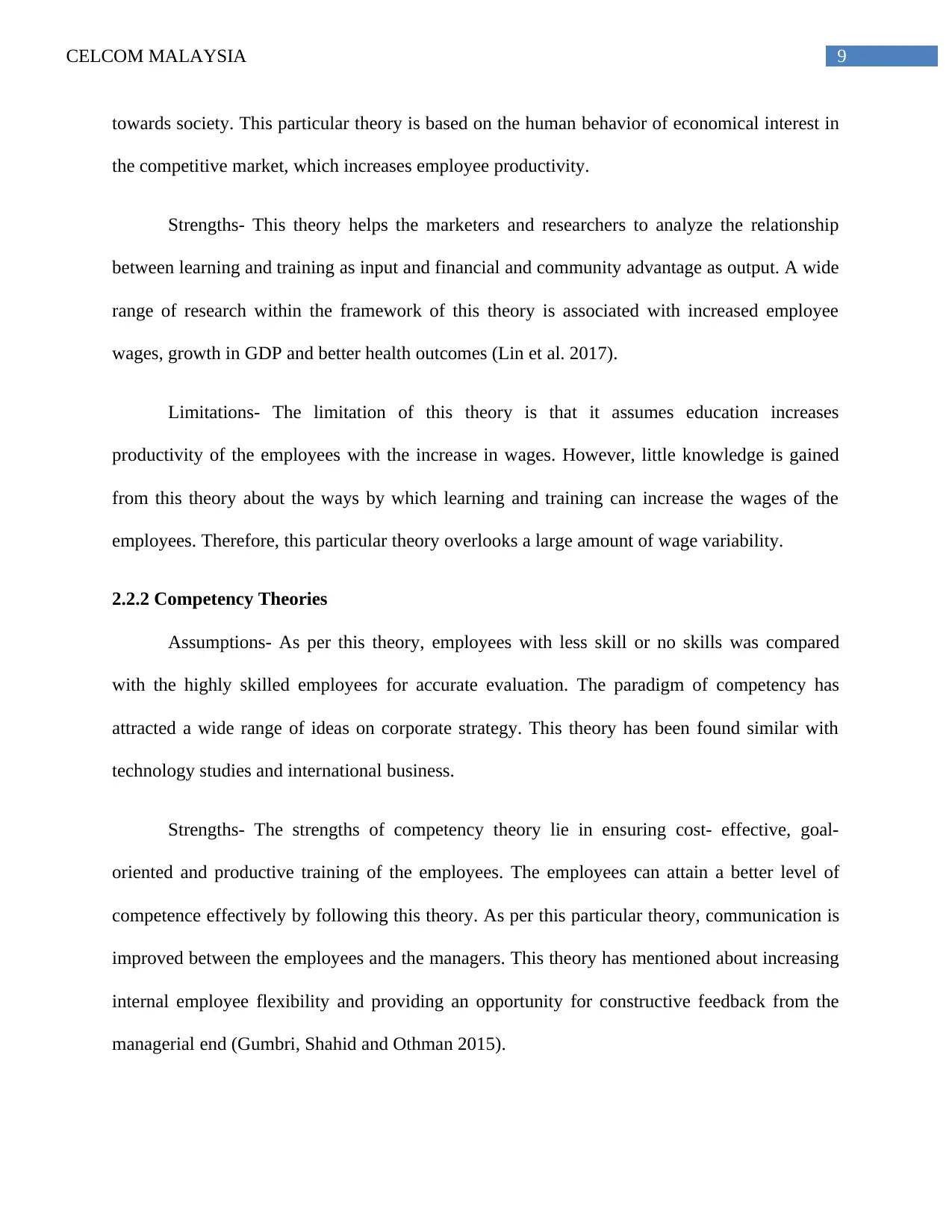
9CELCOM MALAYSIA
towards society. This particular theory is based on the human behavior of economical interest in
the competitive market, which increases employee productivity.
Strengths- This theory helps the marketers and researchers to analyze the relationship
between learning and training as input and financial and community advantage as output. A wide
range of research within the framework of this theory is associated with increased employee
wages, growth in GDP and better health outcomes (Lin et al. 2017).
Limitations- The limitation of this theory is that it assumes education increases
productivity of the employees with the increase in wages. However, little knowledge is gained
from this theory about the ways by which learning and training can increase the wages of the
employees. Therefore, this particular theory overlooks a large amount of wage variability.
2.2.2 Competency Theories
Assumptions- As per this theory, employees with less skill or no skills was compared
with the highly skilled employees for accurate evaluation. The paradigm of competency has
attracted a wide range of ideas on corporate strategy. This theory has been found similar with
technology studies and international business.
Strengths- The strengths of competency theory lie in ensuring cost- effective, goal-
oriented and productive training of the employees. The employees can attain a better level of
competence effectively by following this theory. As per this particular theory, communication is
improved between the employees and the managers. This theory has mentioned about increasing
internal employee flexibility and providing an opportunity for constructive feedback from the
managerial end (Gumbri, Shahid and Othman 2015).
towards society. This particular theory is based on the human behavior of economical interest in
the competitive market, which increases employee productivity.
Strengths- This theory helps the marketers and researchers to analyze the relationship
between learning and training as input and financial and community advantage as output. A wide
range of research within the framework of this theory is associated with increased employee
wages, growth in GDP and better health outcomes (Lin et al. 2017).
Limitations- The limitation of this theory is that it assumes education increases
productivity of the employees with the increase in wages. However, little knowledge is gained
from this theory about the ways by which learning and training can increase the wages of the
employees. Therefore, this particular theory overlooks a large amount of wage variability.
2.2.2 Competency Theories
Assumptions- As per this theory, employees with less skill or no skills was compared
with the highly skilled employees for accurate evaluation. The paradigm of competency has
attracted a wide range of ideas on corporate strategy. This theory has been found similar with
technology studies and international business.
Strengths- The strengths of competency theory lie in ensuring cost- effective, goal-
oriented and productive training of the employees. The employees can attain a better level of
competence effectively by following this theory. As per this particular theory, communication is
improved between the employees and the managers. This theory has mentioned about increasing
internal employee flexibility and providing an opportunity for constructive feedback from the
managerial end (Gumbri, Shahid and Othman 2015).
Paraphrase This Document
Need a fresh take? Get an instant paraphrase of this document with our AI Paraphraser
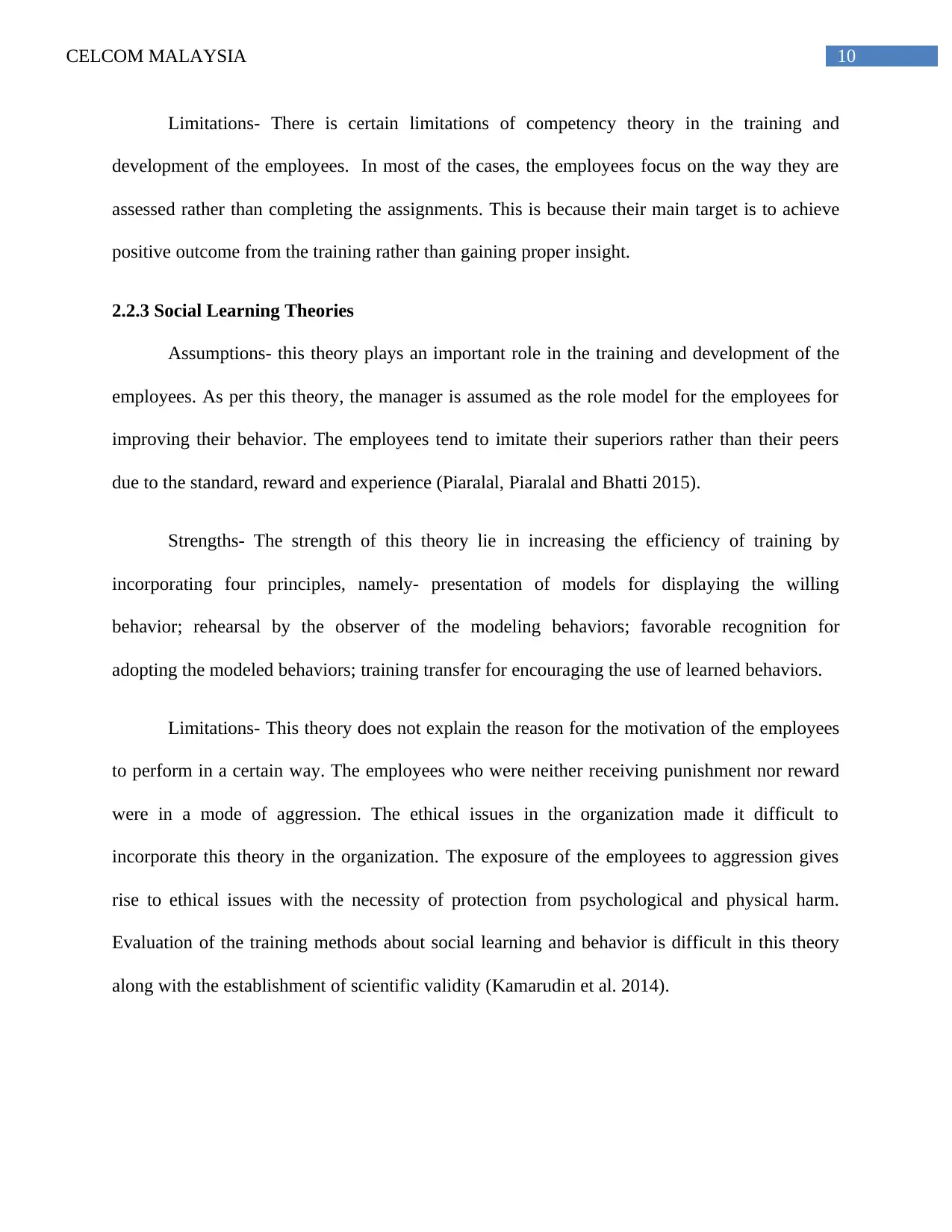
10CELCOM MALAYSIA
Limitations- There is certain limitations of competency theory in the training and
development of the employees. In most of the cases, the employees focus on the way they are
assessed rather than completing the assignments. This is because their main target is to achieve
positive outcome from the training rather than gaining proper insight.
2.2.3 Social Learning Theories
Assumptions- this theory plays an important role in the training and development of the
employees. As per this theory, the manager is assumed as the role model for the employees for
improving their behavior. The employees tend to imitate their superiors rather than their peers
due to the standard, reward and experience (Piaralal, Piaralal and Bhatti 2015).
Strengths- The strength of this theory lie in increasing the efficiency of training by
incorporating four principles, namely- presentation of models for displaying the willing
behavior; rehearsal by the observer of the modeling behaviors; favorable recognition for
adopting the modeled behaviors; training transfer for encouraging the use of learned behaviors.
Limitations- This theory does not explain the reason for the motivation of the employees
to perform in a certain way. The employees who were neither receiving punishment nor reward
were in a mode of aggression. The ethical issues in the organization made it difficult to
incorporate this theory in the organization. The exposure of the employees to aggression gives
rise to ethical issues with the necessity of protection from psychological and physical harm.
Evaluation of the training methods about social learning and behavior is difficult in this theory
along with the establishment of scientific validity (Kamarudin et al. 2014).
Limitations- There is certain limitations of competency theory in the training and
development of the employees. In most of the cases, the employees focus on the way they are
assessed rather than completing the assignments. This is because their main target is to achieve
positive outcome from the training rather than gaining proper insight.
2.2.3 Social Learning Theories
Assumptions- this theory plays an important role in the training and development of the
employees. As per this theory, the manager is assumed as the role model for the employees for
improving their behavior. The employees tend to imitate their superiors rather than their peers
due to the standard, reward and experience (Piaralal, Piaralal and Bhatti 2015).
Strengths- The strength of this theory lie in increasing the efficiency of training by
incorporating four principles, namely- presentation of models for displaying the willing
behavior; rehearsal by the observer of the modeling behaviors; favorable recognition for
adopting the modeled behaviors; training transfer for encouraging the use of learned behaviors.
Limitations- This theory does not explain the reason for the motivation of the employees
to perform in a certain way. The employees who were neither receiving punishment nor reward
were in a mode of aggression. The ethical issues in the organization made it difficult to
incorporate this theory in the organization. The exposure of the employees to aggression gives
rise to ethical issues with the necessity of protection from psychological and physical harm.
Evaluation of the training methods about social learning and behavior is difficult in this theory
along with the establishment of scientific validity (Kamarudin et al. 2014).
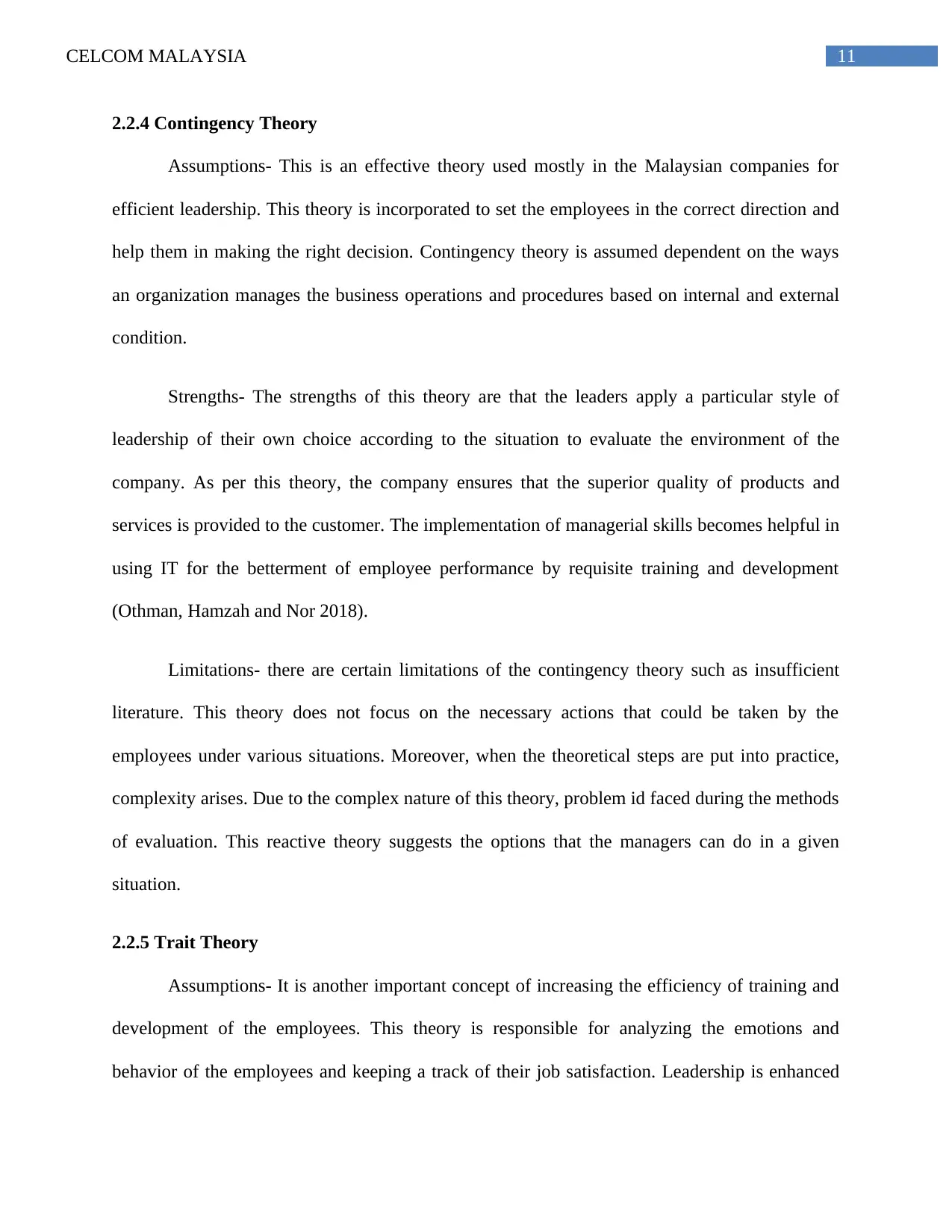
11CELCOM MALAYSIA
2.2.4 Contingency Theory
Assumptions- This is an effective theory used mostly in the Malaysian companies for
efficient leadership. This theory is incorporated to set the employees in the correct direction and
help them in making the right decision. Contingency theory is assumed dependent on the ways
an organization manages the business operations and procedures based on internal and external
condition.
Strengths- The strengths of this theory are that the leaders apply a particular style of
leadership of their own choice according to the situation to evaluate the environment of the
company. As per this theory, the company ensures that the superior quality of products and
services is provided to the customer. The implementation of managerial skills becomes helpful in
using IT for the betterment of employee performance by requisite training and development
(Othman, Hamzah and Nor 2018).
Limitations- there are certain limitations of the contingency theory such as insufficient
literature. This theory does not focus on the necessary actions that could be taken by the
employees under various situations. Moreover, when the theoretical steps are put into practice,
complexity arises. Due to the complex nature of this theory, problem id faced during the methods
of evaluation. This reactive theory suggests the options that the managers can do in a given
situation.
2.2.5 Trait Theory
Assumptions- It is another important concept of increasing the efficiency of training and
development of the employees. This theory is responsible for analyzing the emotions and
behavior of the employees and keeping a track of their job satisfaction. Leadership is enhanced
2.2.4 Contingency Theory
Assumptions- This is an effective theory used mostly in the Malaysian companies for
efficient leadership. This theory is incorporated to set the employees in the correct direction and
help them in making the right decision. Contingency theory is assumed dependent on the ways
an organization manages the business operations and procedures based on internal and external
condition.
Strengths- The strengths of this theory are that the leaders apply a particular style of
leadership of their own choice according to the situation to evaluate the environment of the
company. As per this theory, the company ensures that the superior quality of products and
services is provided to the customer. The implementation of managerial skills becomes helpful in
using IT for the betterment of employee performance by requisite training and development
(Othman, Hamzah and Nor 2018).
Limitations- there are certain limitations of the contingency theory such as insufficient
literature. This theory does not focus on the necessary actions that could be taken by the
employees under various situations. Moreover, when the theoretical steps are put into practice,
complexity arises. Due to the complex nature of this theory, problem id faced during the methods
of evaluation. This reactive theory suggests the options that the managers can do in a given
situation.
2.2.5 Trait Theory
Assumptions- It is another important concept of increasing the efficiency of training and
development of the employees. This theory is responsible for analyzing the emotions and
behavior of the employees and keeping a track of their job satisfaction. Leadership is enhanced
⊘ This is a preview!⊘
Do you want full access?
Subscribe today to unlock all pages.

Trusted by 1+ million students worldwide
1 out of 46
Related Documents
Your All-in-One AI-Powered Toolkit for Academic Success.
+13062052269
info@desklib.com
Available 24*7 on WhatsApp / Email
![[object Object]](/_next/static/media/star-bottom.7253800d.svg)
Unlock your academic potential
Copyright © 2020–2025 A2Z Services. All Rights Reserved. Developed and managed by ZUCOL.





